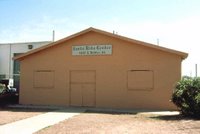 [Source: Dianna M. Náñez, Arizona Republic] -- Time and neglect had taken its toll on the south Phoenix Santa Rita Center, a place filled with unparalleled historical significance to Hispanics. Heaps of old furniture and trash flanked the building. The center, at 10th Street and Hadley, where the late civil rights leader Cesar Chavez staged a 24-day fast, was deteriorating quickly. Without public intervention the Santa Rita Center was on a sure road to becoming another of Arizona's demolished historical treasures. The city wants to make sure that doesn't happen to similar structures.
[Source: Dianna M. Náñez, Arizona Republic] -- Time and neglect had taken its toll on the south Phoenix Santa Rita Center, a place filled with unparalleled historical significance to Hispanics. Heaps of old furniture and trash flanked the building. The center, at 10th Street and Hadley, where the late civil rights leader Cesar Chavez staged a 24-day fast, was deteriorating quickly. Without public intervention the Santa Rita Center was on a sure road to becoming another of Arizona's demolished historical treasures. The city wants to make sure that doesn't happen to similar structures.In November, Phoenix began identifying properties with historical significance to Hispanics. It will take at least six months to survey everything from homes, churches, parks and businesses. The goal is to nominate eligible properties for city, state, and/or national recognition. The Santa Rita Center and Sacred Heart Church are among potential historical structures. "Places like the Santa Rita Center are long since due their place in history," community activist Rosie Lopez said. "Families and future leaders stood by Cesar's side during his fast at Santa Rita. This is the place where Arizona's Chicano movement started."
In 1972, on loan from the Catholic Church, Santa Rita became a temporary shelter for Chavez and his supporters during his "fast for love." Hundreds of local and national leaders joined Chavez to bring attention to the plight of Arizona farm workers after then-Gov. Jack Williams signed a bill outlawing boycotts and strikes during harvest time, making it virtually impossible for workers to organize a union. Thirty-one years later, it would be hard for anyone looking at the crumbling exterior of Santa Rita Center to believe it was once a place of pride and triumph.
[Note: To read the full article, click here. Photo source: City of Phoenix Historic Preservation Office.]